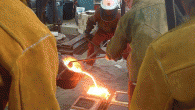May 2, 2016 | BY LIZZIE MACINTOSH, FOR THE DAILY MISSISSIPPIAN

Photo courtesy of the Department of Art
A furnace provided a humming wall of sound as more metal scraps were added to it. The helmeted and suited teams then poured molten iron on the molds they had created. A spray of sparks followed a burst of flames.
Iron pours are no joking matter – but nothing at 2,800 degrees is. The steps are hot and sweaty and use laborious process, and, by the nature of the metals used, they can also be potentially dangerous.
On Friday, the Department of Art and Art History hosted an iron pour for students to get hands-on experience in the world of sculpturing.
Sculpture instructor and artist Stacey Rathert has participated in pours in 15 states and multiple countries.
Rathert said the goal of the iron pour is for students to make art and apply the techniques they have learned throughout the semester.
“The students in the intermediate sculpture class work through a variety of casting materials as well as welding throughout the semester,” Rathert said. “The iron pour is an opportunity for those students, as well as others involved, to make their artwork come to life in cast iron.”
Rather said the art department administration try organize at least one pour a semester for the students in the intermediate class, and more pours depending on what other students might be making in the advanced or graduate student classes.
 Rathert compared the process of casting iron to baking cookies. Similar to the baking process, the oven has to be preheated, ingredients have to be mixed and the product has to be baked. The preparation started Thursday night and resumed around 9 a.m. Friday.
Rathert compared the process of casting iron to baking cookies. Similar to the baking process, the oven has to be preheated, ingredients have to be mixed and the product has to be baked. The preparation started Thursday night and resumed around 9 a.m. Friday.
The oven in this scenario is called a cupola or blast furnace. It uses a combination of solid fuel called coke and forced air to reach a temperature of at least 2,800 degrees. To get the oven to that temperature there is a preheating process known as a burn in.
The ingredients for this product include charges of iron, fuel and flux in a ratio based on the furnace’s size, similar to adjusting a recipe. The iron melts inside the furnace and collects in the bottom and stays there held by a plug. When the well is full, the plug is removed – also known as “tapping out” – and the iron is caught in a ladle.
Once the iron is ready, the artists pour the iron into various molds to create different objects, parts and pieces to make the pieces of art. Charges are steadily added and tapped out until all of the molds are filled.
The molds are made of sand mixed with resin. The resin makes the sand set up hard so that the artists can remove the object and have a void to pour the metal during the actual iron pour.
Around 15 students participated in the pour on Friday. This was the first iron pour for most of the students, including B.F.A student Peyton Perry.
“I’m just excited to see how everything turns out,” Perry said.
A backdrop of a heavy storm accompanied the pour. The eerie weather matched the danger and intensity involved in pouring the metal.
Associate professor of sculpture Durant Thompson told participants to not feel rushed because of the weather.
“The rain is actually a blessing,” Thompson told students. “It’s cooling the day.”
Rathert said the nature of the work is what builds the community around it.
“Because of the nature of the material, it takes a lot of work, heat and heavy lifting to melt the metal and make art,” Rathert said. “You can’t do it on your own. You become part of a tight-knit group that almost acts as a second family.”
Participants in the pour had said they had to rely on each other to listen to instructions and know what the next step would be.
Students were split into three teams: a charge crew, a pour crew and a shovel crew.
Students made molds of different shapes and sizes. One student made a mold in the shape of a vine. The sculpture faculty decided to conduct an experiment testing temperatures of objects, including a Big Mac from McDonalds.
“The Big Mac turned out way better than expected,” Rathert said. “It was completely destroyed and what was left was a pretty decent cast iron version of a Big Mac.”
The iron pour confirmed what students have learned in the classroom while creating a tangible piece of art.
With around 30 molds of various sizes and approximately 1,200 pounds of iron poured in about 2 hours, Rathert said the pour went very well.
“A lot of students were able to get involved with many different jobs for the pour and even though we haven’t opened all the molds yet I think everything poured well,” she said. “Overall, the iron pour was a success.”